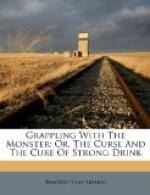“In twenty cases various neurosal disorders had been prominent in the family and its branches, of which neuralgia, chorea, hysteria, eccentricity, mania, epilepsy and inebriety, were most common.
“In some cases, a wonderful periodicity in the outbreak of these disorders was manifested.
“For instance, in one family, for two generations, inebriety appeared in seven out of twelve members, after they had passed forty, and ended fatally within ten years. In another, hysteria, chorea, epilepsy and mania, with drunkenness, came on soon after puberty, and seemed to deflect to other disorders, or exhaust itself before middle life. This occurred in eight out of fourteen, extending over two generations. In another instance, the descendants of three generations, and many of the collateral branches, developed inebriety, mental eccentricities, with other disorders bordering on mania, at about thirty-five years of age. In some cases this lasted only a few years, in others a lifetime.”
And here let us say that in this matter of an inherited appetite there is a difference of views with some who believe that appetite is never transmitted but always acquired. This difference of view is more apparent than real. It is not the drunkard’s appetite that is transmitted, but the bias or proclivity which renders the subject of such an inherited tendency more susceptible to exciting causes, and therefore in greater danger from the use of alcoholic drinks than others.
Dr. N.S. Davis, in an article in the Washingtonian, published at Chicago, presents the opposite view of the case. The following extract from this article is well worthy to be read and considered:
“If we should say that man is so constituted that he is capable of feeling weary, restless, despondent and anxious, and that he instinctively desires to be relieved of these unpleasant feelings, we should assert a self-evident fact. And we should thereby assert all the instincts or natural impulse there is in the matter. It is simply a desire to be relieved from unpleasant feelings, and does not, in the slightest degree, indicate or suggest any particular remedy. It no more actually suggests the idea of alcohol or opium than it does bread and water. But if, by accident, or by the experience of others, the individual has learned that his unpleasant feelings can be relieved, for the time being, by alcohol, opium or any other exhilarant, he not only uses the remedy himself, but perpetuates a knowledge of the same to others. It is in this way, and this only, that most of the nations and tribes of our race, have, much to their detriment, found a knowledge of some kind of intoxicant. The same explanation is applicable to the supposed ‘constitutional susceptibility,’ as a primary cause of intemperance. That some persons inherit a greater degree of nervous and organic susceptibility than others, and are, in consequence of this greater susceptibility, more readily affected by a given quantity of narcotic, anaesthetic or intoxicant, is undoubtedly true. And that such will




